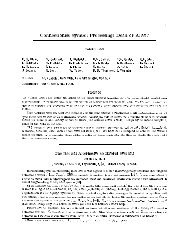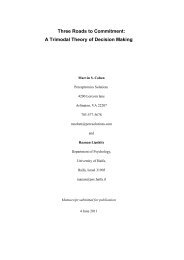Three Roads to Commitment: A Trimodal Theory of Decision Making
Three Roads to Commitment: A Trimodal Theory of Decision Making
Three Roads to Commitment: A Trimodal Theory of Decision Making
Create successful ePaper yourself
Turn your PDF publications into a flip-book with our unique Google optimized e-Paper software.
<strong>Three</strong> <strong>Roads</strong> <strong>to</strong> <strong>Commitment</strong>: A <strong>Trimodal</strong> <strong>Theory</strong> <strong>of</strong> <strong>Decision</strong> <strong>Making</strong> 17<br />
information was received. This must be mistaken if there is one right answer <strong>to</strong> a decision problem.<br />
But the latter assumption, along with the allegation <strong>of</strong> bias, can itself be mistaken – especially in complex,<br />
novel situations where reassessment is most needed. In such cases, reassessment “searches” in a landscape that it<br />
must construct as it goes along, without knowledge <strong>of</strong> the variables and values that will turn out <strong>to</strong> be relevant, and<br />
which is in any case <strong>to</strong>o large or irregular for anything close <strong>to</strong> exhaustive exploration. Reassessment adapts <strong>to</strong> such<br />
problems by starting <strong>to</strong> search in a relatively familiar neighborhood <strong>of</strong> causes, predictions, plans, and outcomes,<br />
changing only what looks wrong, and moving <strong>to</strong> a new neighborhood only when the current one appears beyond<br />
repair (Lindblom, 1959; Braybrooke & Lindblom, 1963; Connolly & Wager, 1988). Reassessment’s bias in favor <strong>of</strong><br />
current commitments reflects a reasonable initial judgment about where solutions are likely <strong>to</strong> be found, hence, it<br />
provides an anchor that improves the prospects <strong>of</strong> generating new knowledge (Politeik, 2001). More pragmatically,<br />
it is less disruptive <strong>of</strong> on-going practice, reduces decision making costs, preserves more existing knowledge, and<br />
frees resources for innovation in less risky or disruptive ways. In the context <strong>of</strong> non-exhaustive search in an illdefined<br />
search space, rational explorers may come <strong>to</strong> different conclusions because they have different starting<br />
points. Allegations <strong>of</strong> irrationality and bias need <strong>to</strong> be reassessed.<br />
The Non-Universality <strong>of</strong> Choice<br />
In the standard s<strong>to</strong>ry, choice is not just the dominant type <strong>of</strong> decision making but it is the only kind, by<br />
definition. In fact, conscious choice may itself be the least indispensable decision mode (a better case may be made<br />
for unconscious allocation <strong>of</strong> time, as we discuss later). Its functions can be emulated by serial generation and<br />
evaluation <strong>of</strong> individual actions by matching and reassessment respectively. For example, satisficing, which retains a<br />
course <strong>of</strong> action if it clears aspiration levels on all evaluative dimensions, is a hybrid <strong>of</strong> matching and reassessment<br />
that approximates choice, especially if reassessment focuses on consequences. Satisficing performs virtually as well<br />
as optimal choice models when there is a stable set <strong>of</strong> satisfac<strong>to</strong>ry options that do not differ drastically in expected<br />
utility (Gigerenzer & Goldstein, 1996). Genuine conscious choice in TDM requires awareness <strong>of</strong> a pool <strong>of</strong><br />
concurrently available options that start out on a roughly equal footing with respect <strong>to</strong> the decision (as opposed <strong>to</strong><br />
satisficing, and reassessment more generally, where results are highly path-dependent). <strong>Decision</strong>s tend <strong>to</strong> be framed<br />
as choice when (a) multiple options are prepackaged for comparison in the environment (e.g., a web site that<br />
provides a table <strong>of</strong> products by features), (b) cultural or organizational constraints require justification by<br />
comparison with other options (Tetlock, 1996), or (c) goals compete with one another, which is <strong>to</strong> say that salient<br />
options trade <strong>of</strong>f advantages and disadvantages or compete for scarce resources, and some approximation <strong>to</strong>




